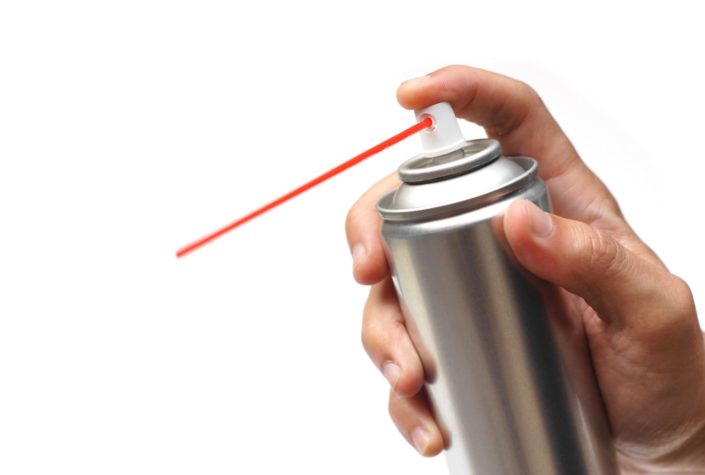Inhalant abuse is the intentional inhalation of vapors from commercial products or specific chemical agents to achieve a “high.” Abusers may inhale products directly through the mouth, from a bag which the agent has been sprayed into, or from a rag containing the chemical being placed over the nose and/or mouth. The intoxication or “high” is immediate, yet short-lived. Many inhalers will continually repeat this process in order to maintain this euphoria (American Psychiatric Association (APA) 2000). Almost any aerosol or liquid solvent can be used as an inhalant. Examples of common inhalants include:
- Aerosols – Duster (electronic device cleaner), spray paint, hair spray, deodorant, air freshener, analgesic spray, asthma spray, fabric spray.
- Glues and Adhesives – airplane glue; other glues and cements.
- Anesthetics – Nitrous Oxide (gaseous), Halothane (liquid), Ethyl Chloride (local).
- Cleaning Agents – Dry cleaning/spot removers, degreaser, lacquer, paint thinners.
- Solvents and Gasses – Nail polish remover, paint remover, correction fluid, fuel gas, lighter fluid.
- Asphyxiants – Helium, Butane, Propane, others.
Although teenagers are still experimenting with inhalants and need to be fully educated regarding the dangers of this practice, individuals over the age of 18 years old are becoming the largest group of inhalant users in the U.S. Although the popularity of different inhalant products change with the age of the user and geographic location, propellants continue to be the most popular inhalant as identified by the National Poison Data System (NPDS).
Inhalants are easy to get because they are legal and cheap. Teenagers often try inhalants before they try alcohol, cigarettes, or other drugs.
Symptoms of Inhalant Abuse
It can be hard to recognize the signs of inhalant abuse. Individuals who use inhalants may show some of the following signs.
- Bloodshot or dilated eyes.
- Chapped lips or face.
- Thermal burns on the face, mouth, tongue and oral cavity (dusters).
- Runny nose or frequent nosebleeds.
- Chemical-like odor on their breath.
- Chemical or paint stains on their hands and clothes
- Appearing drunk or high.
- Slurred speech.
Inhalant users may exhibit some of the following symptoms.
- headaches
- dizziness
- nausea and vomiting
- memory loss
- trouble sleeping
- depression and anxiety
- vision problems (involuntary eye movement)
- muscle weakness
Methods of Inhalant Intake
There are several ways that a person can abuse inhalants.
- Snorting – Breathing product fumes directly from the container through the nasal cavity.
- Huffing – Inhaling products sprayed directly into the mouth or nose, or spraying the product on a rag and then placing it over the nose or mouth to inhale.
- Bagging – Pouring or spraying the product into a bag and then holding it over the mouth and nose for inhaling.
How is Inhalant Abuse Diagnosed?
If you think your child, a friend, or another family member is abusing inhalants, talk to them. Be honest and open. Explain the serious dangers of inhalant abuse. Let them know you are concerned and want to help.
If you learn that inhalants are being used by this individual, offer them guidance in seeking treatment. Anyone found unconscious or showing severe physical signs of inhalant abuse needs medical treatment immediately – call 911.
Can Inhalant Abuse be Prevented or Avoided?
Talking with children and family members regarding the dangers of inhalant abuse is an important component of inhalant abuse prevention. Ensuring that the dangers of inhalant abuse is included in school curriculums and counseling programs is also vital. Getting inhalant abuse information to parent groups and making it available for school parent nights and other events can also inform communities. Although education is an important component in the fight against inhalant abuse, ensuring that popular inhalant products are being distributed in a responsible fashion by manufacturers and retailers is a necessity. Access is an extreme problem with popular products and may need to be addressed through regulation. Any efforts a person makes to address this problem is will make a difference.
Inhalant Abuse Treatment
Minor symptoms of inhalant abuse can be treated with over-the-counter medicines. Major symptoms, such as heart arrhythmias, require proper medical action- call 911.
The most important part of treatment is to stop the abuse. This requires a person to abstain from using inhalants. Individuals may need to see a counselor or attend a support or rehab program.
Dangers Associated With Inhalant Abuse
Inhalant abuse puts users of any age at risk of harm. Not only is there sever physical and neurological damage, inhalant drivers can kill themselves or others when operating a vehicle while impaired by an inhalant. Individuals can also incur severe physical damage to themselves when they collapse from becoming unconscious while inhaling.
All fluorinated hydrocarbons (difluoroethane, trichlofluoromethane, bromotrifluoromethane and others) when inhaled can cause cardiac arrhythmias which lead to heart failure and death (Sudden Sniffing Death). This event may occur on the first inhaling incident or the twentieth. An individual will never know. This is the most common form of death due to inhalants.
Questions To Ask Your Doctor
- What are the dangers of inhalant abuse?
- What are some common household items that are inhaled?
- How can I tell if my family member is abusing inhalants?
- How can I prevent my family member from abusing inhalants?
- How can I start a discussion about inhalant abuse with my child?


Leave a Reply